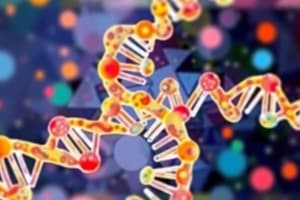Podcast
Questions and Answers
Which enzyme is primarily responsible for DNA synthesis in prokaryotic DNA replication?
Which enzyme is primarily responsible for DNA synthesis in prokaryotic DNA replication?
- DNA pol III (correct)
- RNA primase
- DNA pol I
- DNA pol II
What is the function of the sliding clamp in prokaryotic DNA replication?
What is the function of the sliding clamp in prokaryotic DNA replication?
- To prevent single-stranded DNA from winding back into a double helix
- To hold DNA polymerase in place (correct)
- To seal the nicks between newly synthesized DNA and previously synthesized DNA
- To unwind DNA by breaking hydrogen bonds
What is the difference between the leading strand and the lagging strand in prokaryotic DNA replication?
What is the difference between the leading strand and the lagging strand in prokaryotic DNA replication?
- The leading strand and the lagging strand are synthesized in the same way
- The leading strand requires a new primer for each fragment, while the lagging strand is synthesized continuously
- The leading strand is synthesized in Okazaki fragments, while the lagging strand is synthesized continuously
- The leading strand is synthesized continuously, while the lagging strand is synthesized in Okazaki fragments (correct)
Flashcards are hidden until you start studying
Study Notes
Prokaryotic DNA Replication: Key Players and Process
- Prokaryotic DNA replication is well studied due to small genome size and availability of mutants.
- E. coli has a single circular chromosome of 4.6 million base pairs that gets replicated in about 42 minutes.
- DNA polymerase is a key enzyme that adds nucleotides to the growing DNA chain, requiring energy from nucleotides with three phosphates.
- DNA pol III is the enzyme required for DNA synthesis, while DNA pol I and II are primarily for repair.
- Origins of replication are specific nucleotide sequences where replication begins, recognized by proteins that bind to the site.
- Helicase unwinds DNA by breaking hydrogen bonds, forming Y-shaped replication forks that extend bidirectionally from the origin of replication.
- Single-strand binding proteins prevent the single-stranded DNA from winding back into a double helix.
- DNA polymerase extends the new DNA strand in the 5' to 3' direction, requiring a free 3'-OH group to add nucleotides.
- RNA primase synthesizes an RNA primer that provides the free 3'-OH end for DNA polymerase to add nucleotides.
- The leading strand is synthesized continuously, while the lagging strand is synthesized in Okazaki fragments and requires a new primer for each fragment.
- The sliding clamp holds the DNA polymerase in place, while topoisomerase prevents over-winding of the DNA double helix ahead of the replication fork.
- DNA ligase seals the nicks between newly synthesized DNA and previously synthesized DNA, completing the replication process.
Studying That Suits You
Use AI to generate personalized quizzes and flashcards to suit your learning preferences.




